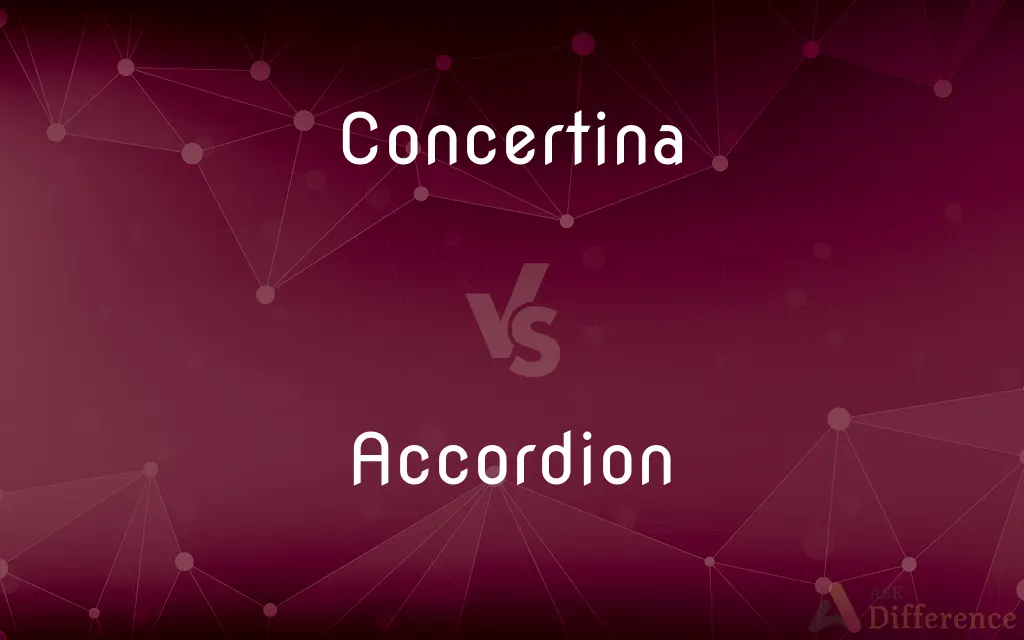Concertina vs. Accordion — What's the Difference?
By Tayyaba Rehman & Fiza Rafique — Updated on March 25, 2024
A concertina plays a different note on push and pull, focusing on melody, while an accordion maintains the same note, often used for chords and rhythm.

Difference Between Concertina and Accordion
Table of Contents
ADVERTISEMENT
Key Differences
Concertinas and accordions are both free-reed instruments, yet they differ significantly in their design and sound. Concertinas typically have buttons at either end, producing distinct notes when the bellows are pushed or pulled. On the other hand, accordions have a keyboard or buttons on one side and bass buttons on the other, and they produce the same note whether the bellows are expanded or compressed.
The physical structure of concertinas is more compact, with a hexagonal shape, and they often have fewer buttons than accordions. This design contributes to the concertina's portability and its distinctive, sharp sound, which is especially popular in maritime and traditional English music.
Accordions, with their larger size and more complex button or keyboard layout, offer a broader range of notes and chords. This versatility allows accordion players to perform a wide range of musical styles, from polkas and waltzes to jazz and rock, making it a staple in many cultural music traditions around the world.
While concertinas are more commonly associated with solo performances due to their clear, melodic sound, accordions often find their place in ensemble settings, where their harmonic and rhythmic capabilities can be fully utilized to complement other instruments.
Comparison Chart
Note Variation
Different note on push and pull
Same note on both push and pull
ADVERTISEMENT
Design
Compact, hexagonal, fewer buttons
Larger, keyboard or buttons and bass buttons
Sound
Sharp, suited for melody
Broad, suited for chords and rhythm
Use
Solo performances, traditional music
Ensemble settings, diverse musical styles
Origin
England, 19th century
Europe, early 19th century
Compare with Definitions
Concertina
A small musical instrument with bellows and buttons, producing different notes when pushed and pulled.
She played a haunting melody on her concertina at the folk festival.
Accordion
A keyboard or button-based musical instrument with a set of bellows, producing the same note on push and pull.
The accordion player filled the room with the vibrant sounds of a lively polka.
Concertina
Primarily used in traditional, folk, and maritime music for its clear, melodic sound.
The concertina's distinctive sound added an authentic touch to the traditional Irish music session.
Accordion
Characterized by its size and the combination of melody keys or buttons and bass buttons.
He practiced daily, mastering the accordion's complex array of buttons and keys.
Concertina
The concertina offers a wide range of pitches despite its small size, making it versatile in solo performances.
The musician demonstrated the concertina's versatility by playing both high and low pitches.
Accordion
Versatile in genres, the accordion is a staple in folk, classical, jazz, and popular music.
The band's accordionist played an eclectic mix, from classic waltzes to modern tunes.
Concertina
Often hexagonal in shape, the concertina is known for its compact design and portability.
The sailor carried his concertina everywhere, playing tunes during long voyages.
Accordion
The accordion's ability to produce chords makes it ideal for rhythm and accompaniment in ensembles.
With the accordion's rhythmic chords, the ensemble's music gained a rich, full-bodied sound.
Concertina
Concertinas are often played using a finger technique that allows for rapid note changes.
Her fingers danced across the concertina's buttons, weaving a complex melody.
Accordion
Accordions are larger and can be more challenging to learn due to the complexity of their keyboard and bass system.
Learning the accordion was challenging, but its rich sound and versatility made it worthwhile.
Concertina
A concertina is a free-reed musical instrument, like the various accordions and the harmonica. It consists of expanding and contracting bellows, with buttons (or keys) usually on both ends, unlike accordion buttons, which are on the front.
Accordion
Accordions (from 19th-century German Akkordeon, from Akkord—"musical chord, concord of sounds") are a family of box-shaped musical instruments of the bellows-driven free-reed aerophone type, colloquially referred to as a squeezebox. A person who plays the accordion is called an accordionist.
Concertina
A small instrument with bellows like an accordion but with buttons in place of keys.
Accordion
A musical instrument played by stretching and squeezing with the hands to work a central bellows that blows air over metal reeds, the melody and chords being sounded by buttons or keys.
Her five brothers and sisters were singing to the accompaniment of an accordion
An accordion player
Concertina
(musical instruments) A musical instrument, like the various accordions, that is a member of the free-reed family of musical instruments, typically having buttons on both ends.
Accordion
A portable wind instrument with a small keyboard and free metal reeds that sound when air is forced past them by pleated bellows operated by the player.
Concertina
Something resembling a concertina, such as a folded book, a bus door or a set of picture frames that are folded together.
Accordion
Having folds or bends like the bellows of an accordion
Accordion pleats.
Accordion blinds.
Concertina
Coiled barbed wire for use as an obstacle.
Accordion
A box-shaped musical instrument with means of keys and buttons, whose tones are generated by play of the wind from a squeezed bellows upon free metallic reeds.
Concertina
A type of booklet label, consisting of up to 32 pages of booklet as an insert.
Accordion
(GUI) A vertical list of items that can be individually expanded and collapsed to reveal their contents.
Concertina
To become compressed into a shape reminiscent of a concertina
The car concertinaed into the wall.
Accordion
(figurative) A set of items (concepts, links, or otherwise) that can be packed and unpacked cognitively, or their representation as a set of virtual object. en
Concertina
To be drawn closer and farther apart repeatedly, or up and down, as if situated on a working concertina's folds
Accordion
To fold up, in the manner of an accordion
Concertina
A small musical instrument on the principle of the accordion. It is a small elastic box, or bellows, having free reeds on the inside, and keys and handles on the outside of each of the two hexagonal heads.
Accordion
A small, portable, keyed wind instrument, whose tones are generated by play of the wind upon free metallic reeds.
Concertina
Coiled barbed wire used as an obstacle
Accordion
A portable box-shaped free-reed instrument; the reeds are made to vibrate by air from the bellows controlled by the player
Concertina
Free-reed instrument played like an accordion by pushing its ends together to force air through the reeds
Accordion
Arranged in parallel folds;
Plicate leaves
Concertina
Collapse like a concertina
Common Curiosities
Can a concertina play chords like an accordion?
Yes, a concertina can play chords, but with fewer buttons than an accordion, the range and complexity of chords are more limited.
Can both instruments be used in any type of music?
While both can adapt to various musical styles, concertinas are more traditional in folk and maritime music, whereas accordions are versatile in a wider range of genres.
Are concertinas cheaper than accordions?
Concertinas can be both cheaper and more expensive than accordions, depending on the type, brand, and quality. Beginner models of both instruments can be relatively affordable.
Is one instrument better for solo performances?
Concertinas, with their clear melodic sound, are often favored for solo performances, but accordions can also be used solo, especially in genres that utilize its chordal capabilities.
Are there different types of concertinas and accordions?
Yes, there are several types of concertinas (e.g., English, Anglo, Duet) and accordions (e.g., piano, chromatic, diatonic), each with unique features.
Is the accordion harder to learn than the concertina?
Due to its larger size and more complex button or keyboard layout, the accordion can be more challenging to master than the simpler concertina.
Can accordions play melody and rhythm simultaneously?
Yes, accordions can play melody with the right hand while providing rhythmic chords with the left, making them versatile in ensemble settings.
Can children learn to play the accordion or concertina?
Yes, children can learn both instruments, but the size and complexity of the accordion might make the concertina a more accessible starting point.
Are accordions used in orchestras?
While not as common as other instruments, accordions have been used in orchestral settings, especially in pieces that require their unique sound.
Is it easy to carry a concertina around?
Yes, concertinas are known for their compact size and portability, making them easy to transport.
Are digital versions of these instruments available?
Yes, digital versions of both concertinas and accordions exist, offering electronic sounds and features not found in traditional acoustic models.
Do both instruments originate from the same country?
No, the concertina was developed in England, while the accordion has origins in early 19th-century Europe.
Do concertinas and accordions sound similar?
While they have a similar timbre due to both being free-reed instruments, their sound and playing techniques differ significantly.
Do concertinas require maintenance?
Yes, like all musical instruments, concertinas require regular maintenance to ensure their best performance, including care of the bellows and buttons.
Share Your Discovery

Previous Comparison
Work vs. Works
Next Comparison
Toddler vs. InfantAuthor Spotlight
Written by
Tayyaba RehmanTayyaba Rehman is a distinguished writer, currently serving as a primary contributor to askdifference.com. As a researcher in semantics and etymology, Tayyaba's passion for the complexity of languages and their distinctions has found a perfect home on the platform. Tayyaba delves into the intricacies of language, distinguishing between commonly confused words and phrases, thereby providing clarity for readers worldwide.
Co-written by
Fiza RafiqueFiza Rafique is a skilled content writer at AskDifference.com, where she meticulously refines and enhances written pieces. Drawing from her vast editorial expertise, Fiza ensures clarity, accuracy, and precision in every article. Passionate about language, she continually seeks to elevate the quality of content for readers worldwide.













































